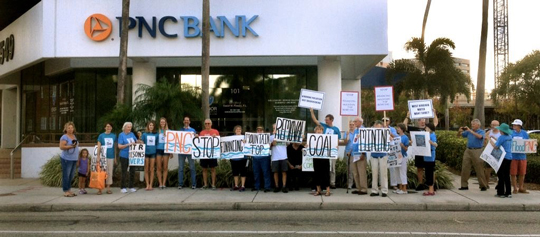 Protesters from the Earth Quaker Action Team (EQAT) demonstrate in Sarasota, Florida—one of 31 U.S. locations—during Flood PNC Day of Action on Dec. 6. | Photo courtesy EQAT
Protesters from the Earth Quaker Action Team (EQAT) demonstrate in Sarasota, Florida—one of 31 U.S. locations—during Flood PNC Day of Action on Dec. 6. | Photo courtesy EQAT
Five ways to make your activism more strategic
By Eileen Flanagan
Thirteen years ago, at an anti-war rally where a small group of protestors gave speeches to each other in a park, my precocious five-year-old looked up at me and said, “Mom, this is not going to change George Bush’s mind. Can we go get ice cream?”
Of course, she was right, though at the time I didn’t know what was missing from all those rallies and marches I’d attended over the years. It was only through my involvement with Earth Quaker Action Team—a group founded five years ago that uses nonviolent direct action to work for a just and sustainable economy—that I learned the following keys to effective activism.
1. Choose one campaign.
There are so many issues that need addressing, it’s tempting to try to do a little bit on all of them, but history shows that picking one and focusing on it for an extended period of time is the best way to get results.
2. Pick a strategic target.
For its first campaign in 2010, the Earth Quaker Action Team (EQAT pronounced “equate”) decided to get PNC Bank to stop financing companies engaged in mountaintop removal coal mining, which contributes to both climate change and high rates of cancer in Appalachia. Was PNC the only bank financing environmental destruction? No, but PNC claims to be a “green” bank, has Quaker roots and as a result, many Quaker customers—vulnerabilities our group was particularly poised to exploit.
 Philadelphia author and activist Eileen Flanagan’s book, Renewable: One Woman’s Search for Simplicity, Faithfulness, and Hope, will be released March 3.
Philadelphia author and activist Eileen Flanagan’s book, Renewable: One Woman’s Search for Simplicity, Faithfulness, and Hope, will be released March 3.
3. Don’t be boring.
Surprising actions are more likely to attract participants and press. For example, EQAT sang, “Where Have All the Flowers Gone” in front of the PNC pavilion at the 2011 Philadelphia Flower Show; walked 200 miles to the bank’s Pittsburgh headquarters in 2012; sang “Which Side Are You On?” to each member of the PNC board during their 2013 shareholder meeting; and last December, organized over 300 people in 12 states and the District of Columbia to hold actions at 31 different bank branches.
4. Be willing to take a risk.
Protesting inside a bank or a shareholder meeting is scarier than speeches out on the sidewalk, but if your goal is to pressure powerful decision makers, it helps to confront them directly. Even if your group is not ready to do civil disobedience—a tactic EQAT occasionally employs—encourage your members to do something just a little bolder than what they’ve done before.
5. Create a dilemma.
One way to escalate the pressure on your target is to create a situation where they lose something no matter what. In the case of the shareholder meeting where Earth Quakers sang to the PNC board, the CEO had a dilemma. He could have the protestors arrested, attracting even more press and disrupting the meeting. Instead, he shut his legally mandated annual meeting down after only seventeen minutes.
By keeping its focus on PNC, EQAT has created an even bigger dilemma for the bank: stop financing companies engaged in mountaintop removal coal mining and risk angering the coal industry, or continue losing customers over this issue, getting bad press, and having activists show up at their meetings, their bank branches, and occasionally their homes. We know they are paying attention to us and believe that a policy change is coming. If we’re right, it won’t just be because we protested, but because we protested strategically.
Get Involved
Before you do anything else, don’t forget that April 20 is the last day to register to vote before the all-important Mayoral primary election. Many Philadelphians are organizing for a just and sustainable future for our city, and these nonprofit groups and others can help you get focused, whether you want to be a donor, get armed with facts, or join an action:





It is my frist visit to your blog. I enjoyed reading here. and I liked your ways to presnet information inproper ways to make it easy to read.
send free text message online